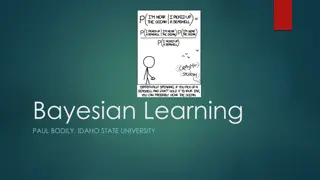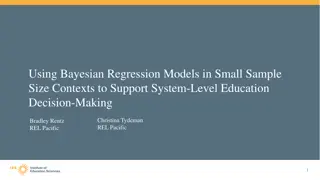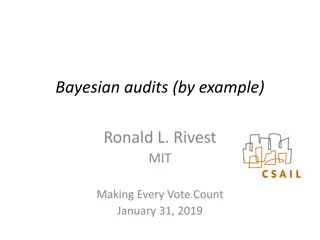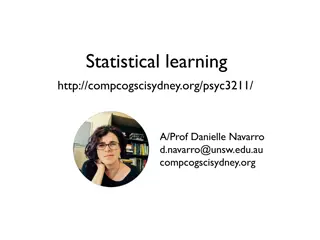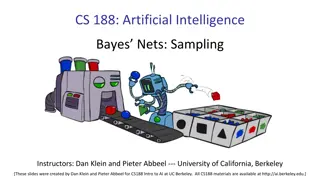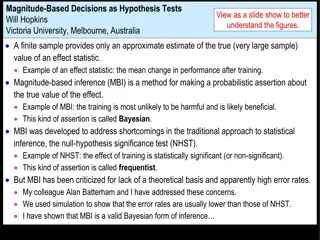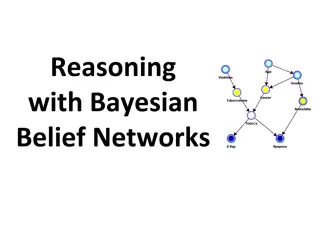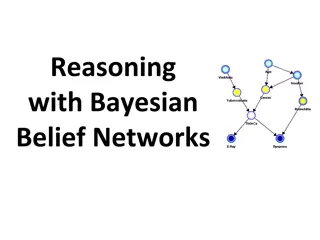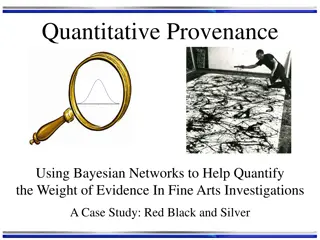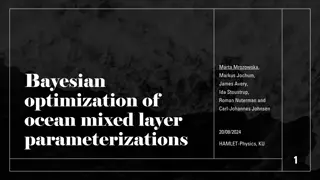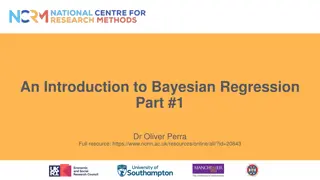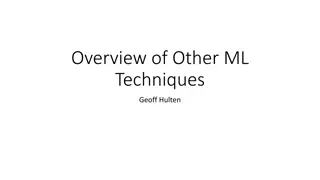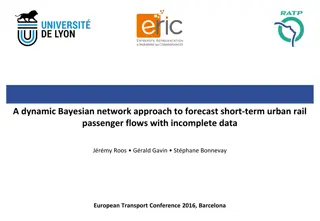Understanding Bayesian Networks: A Comprehensive Overview
Bayesian networks, also known as Bayes nets, provide a powerful tool for modeling uncertainty in complex domains by representing conditional independence relationships among variables. This outline covers the semantics, construction, and application of Bayesian networks, illustrating how they offer a more manageable alternative to full joint probability distributions. Through directed acyclic graphs and conditional probabilities, Bayesian networks offer a structured way to capture causal relationships and make probabilistic inferences.
Download Presentation

Please find below an Image/Link to download the presentation.
The content on the website is provided AS IS for your information and personal use only. It may not be sold, licensed, or shared on other websites without obtaining consent from the author. Download presentation by click this link. If you encounter any issues during the download, it is possible that the publisher has removed the file from their server.
E N D
Presentation Transcript
Bayesian Networks (Bayes Nets) Outline I. Semantics II. Network construction * Figures are either from the textbook site or by the instructor.
I. Knowledge in an Uncertain Domain The full joint probability distribution can answer any question, but it also has several drawbacks: exponential in the number ? of variables and intractable as ? grows very large unnatural and tedious to specify probabilities of outcomes one by one inadequate for representing human reasoning (good at conditional probabilities but poor at joint probabilities) The number of probabilities can be greatly reduced by exploring the absolute and conditional independence relationships among the variables. These dependencies can be concisely represented by a Bayesian network, which can represent any full joint probability distribution.
Bayesian Network A Bayesian network (aka a Bayes net)is a directed acyclic graph (DAG) such that a) every node corresponds to a random variable, either discrete or continuous; b) every edge (?,?) specifies ? (a cause) as a parent of ? (an effect); c) every node ? has associated probability information ? ? parent(?)) that quantifies the effect of the parents on ?. The network topology specifies the conditional independence relationships that hold in the domain.
BN as a Modeling Tool The parents of a node ? are those judged to be direct causes of ? or have direct influence on ?. Weather is independent of the other three variables. Toothache and Catch are conditionally dependent on Cavity, but conditionally independent of each other. The parameters required for model construction are conditional probabilities that quantify cause-effect relations, which are psychologically meaningful often measurable
Burglar Alarm Problem A newly installed burglar alarm is fairly reliable at detecting a burglary. But it can also be occasionally set off by earthquakes. Neighbors John and Mary have promised a call when they hear the alarm. John nearly always calls but sometimes confuses the alarm with the telephone ringing. Mary often misses the alarm because she likes playing loud music. Problem Estimate the probability of a burglary given the evidence of who has or has not called. ? ? = false ?,?) 1 .95 = .05 1 .94 = .06 1 .29 = .71 1 .001 = .999 conditional probability tables (CPTs)
Semantics of a Bayes Net How does the syntax correspond to a joint distribution over the variables? ? variables ?1, ,?? in the network an entry in the joint distribution is defined as Parents ?? ?(?1, ,??) = ?(?1= ?1 ??= ??) ??2 ???? ??1 ? ? ?? | parents(??) 1 ?1, ,??? ? ?=1 where ?? parents ?? = ?? ?? Parents(??)}= ??1, ,???? // the values of Parents(??) that appear in ?1, ,?? ? ?? | parents(??) // probability of ??= ?? given the values of the parents of ?? Every entry in the joint distribution is the product of the appropriate elements of the local conditional distribution.
BN as a Knowledge Base ? ? ?? | parents(??) ?(?1, ,??) = ?=1 Calculate the probability that the alarm has sounded, but neither a burglary nor an earthquake has occurred, and both John and Mary call. ? ?,?,?, ?, ? = ? ? ?) ? ? ?) ? ? ? ?)?( ?)?( ?) Alarm is the sole parent of JohnCalls. Burglary and Earthquake are the only two parents of Alarm. = 0.90 0.70 0.001 0.999 0.998 = 0.000628
Conditional Probabilities Parents(??) ?: all variables other than ?? and Parents(??) ?: values of ? ? ??parents(??)) ?(??,parents(??)) ?(parents(??)) ?? ??(??,parents ??,?) ?? // proof can be derived = ,parents ??,?) ,??(?? ? = ? ?? | parents(??) ? ? ?? | parents(??) ?(?1, ,??) = ?=1 (by definition of the Bayes net) ? Full joint distribution: ? ??parents(??)) ?(?1, ,??) = ?=1
Correct Domain Representation Chain rule: ? ?1, ,?? = ? ?? ?? 1, ,?1)?(?? 1, ,?1) = ? ?? ?? 1, ,?1)? ?? 1 ?? 2, ,?1) ? ?2 ?1)?(?1) ? = ? ?? ?? 1, ,?1) ?=1 Meanwhile, ? ? ??parents(??)) ?(?1, ,??) = ?=1 ? ? ? ??parents ??) ? ?1, ,?? = ? ?? ?? 1, ,?1) = ?=1 ?=1 Joint distribution can be fully specified if, for ? = 1, ,?, Parents ?? ?1, ?? 1 ? ?? ?? 1, ,?1) =? ??Parents(??))
Topological Order Parents ?? ?1, ?? 1for ? = 2, ,? The above is guaranteed if we number the nodes in topological order (which exists since the Bayesian network is a DAG). Four topological orders: ?,?,?,?,? ?,?,?,?,? ?,?,?,?,? ?,?,?,?,? Any one of the four suffices.
II. Construction of the Bayesian Network ? ?? ?? 1, ,?1) =? ??Parents(??)) for ? = 2, ,? The Bayesian network is correct only if ?? is conditionally independent of any ??, 1 ? ? 1, such that ?? Parents(??). Construction algorithm 1. Determine the set of variables that are required to model the domain. 2. Order them as ?1,?2, ,??. Any order works, although network compactness depends on how much the order whether causes precede effects is respected. 3. For ? = 1 to ? do a) Choose a minimal set of parents for ?? from ?1,?2, ,?? 1 such that ? ?? ?? 1, ,?1) =? ??Parents(??)) b) Add a directed edge from every parent to ??. c) Write down the conditional probability table (CPT), ? ??Parents(??)).
Construction (contd) Chosen order: MaryCalls, JohnCalls, Alarm, Burglary, Earthquake. ?(? | ?) > ?(?) MaryCalls // If May calls, that probably means // the alarm has gone off, which // makes John more likely to call. JohnCalls ? ? ?,?) > ? ? | ? ,? ? | ? ,?(?) // If both Mary and John call, the alarm // is more likely to go off than if just // one calls. Alarm
Construction for the Burglary Example MaryCalls, JohnCalls, Alarm, Burglary, Earthquake. ? ? ?,?,?) = ? ? ?) MaryCalls // If the value of ? (either ? or ?) is // known, then the call from John or // Mary does not add any information // about burglary. JohnCalls Alarm ? ? ?,?) > ? ? ? ),? ? ?) // If the alarm is on, it is more likely that // there has been earthquake. If there // has been a burglary, it is slightly more // likely that it happened after an // earthquake. In the occurrences of // both events, the chance of earthquake // occurrence is even higher. Burglary Earthquake
Node Ordering Matters More conditional probabilities than needed. 1 (one probability / parameter) MaryCalls 2 Assessment of unnatural probabilities, e.g., ?(Earthquake | Burglary,Alarm}. JohnCalls (four probabilities) 4 Sticking to a causal model results in fewer probabilities that are also easier to come up with. Alarm 2 4 Burglary Earthquake 10 conditional probabilities 1 + 2 + 4 + 2 + 4 = 13 conditional probabilities
Bad Node Ordering MaryCalls, JohnCalls, Earthquake, Burglary, Alarm. 1 + 2 + 4 + 8 + 16 = 31 distinct probabilities (exactly the same as the full joint distribution)!
Roles of Casualty Deciding conditional independence is hard in noncausal directions. (Causal models and conditional independence seem hardwired for humans!) Assessing conditional probabilities is hard in noncausal directions. The interpretation of directed acyclic graphs as carriers of independence assumptions does not necessarily imply causation. The ubiquity of DAG models in statistical and AI applications stems (often unwittingly) primarily from their causal interpretation. In practice, DAG models are rarely used in any variable ordering other than those which respect the direction of time and causation.
Compactness of Bayes Nets The full joint distribution contains 2? numbers. It is reasonable to assume that each random variable is directly influenced by ? others (i.e., every node has ? parents in a BN). The conditional probability table (CPT) for each node has size 2?. With ? Boolean variables, the network has ? 2? numbers. To avoid a fully connected network, leave out links that represent slight dependencies.



